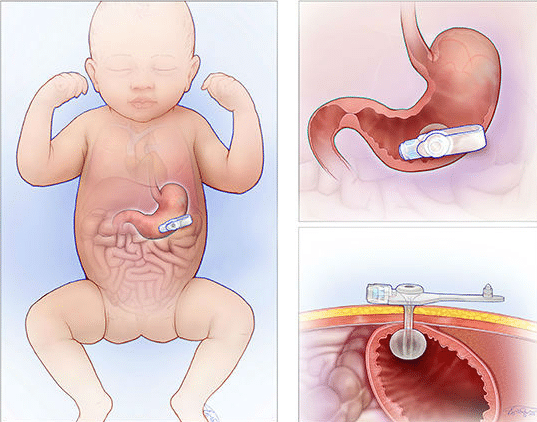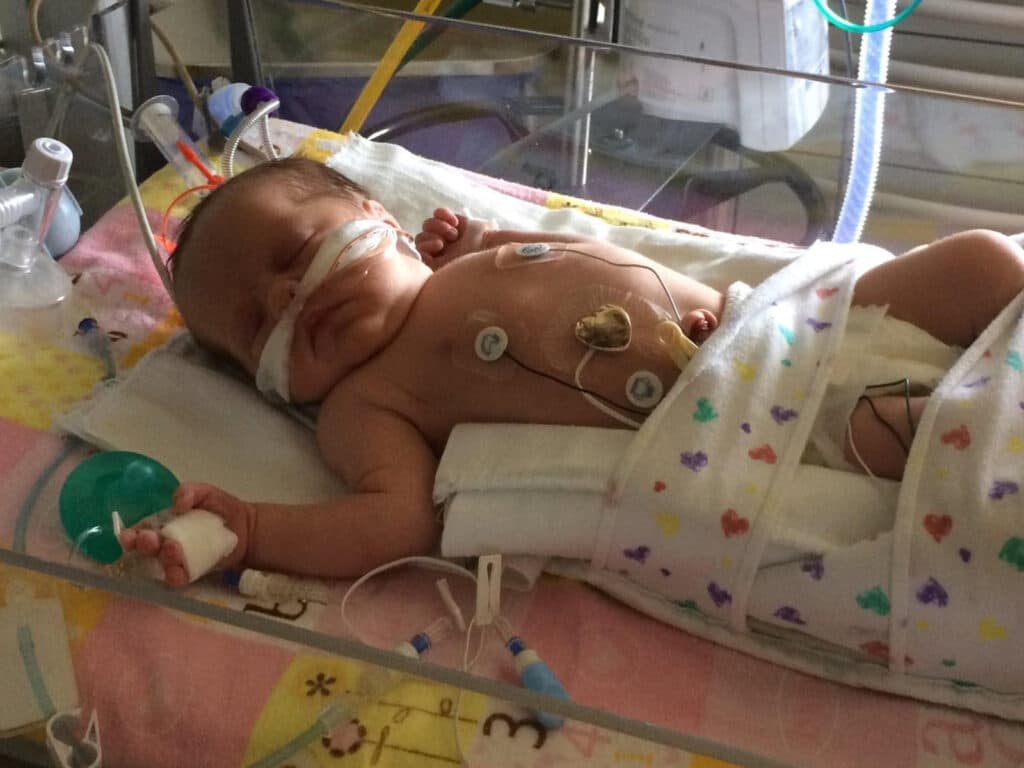
Delivering your twins early and having to deal with feeding tubes can feel overwhelming. But know that you’re not alone! Here are some tips for handling tube feedings in the NICU and at home.

All content on this website, including medical opinions and any other health-related information, is for informational purposes only and should not be considered to be a specific diagnosis or treatment plan for any individual situation. Use of this site and the information contained herein does not create a doctor-patient relationship. Always seek the direct advice of your own doctor in connection with any questions or issues you may have regarding your own health or the health of others.
If one or both of your twinnies requires a feeding tube after birth, my heart goes out to you. I’ve been there too. While the situation is not ideal, know that you are not alone in facing the challenges of an infant feeding tube.
Whether you’re still expecting and worried about prematurity or you’re in the midst of tube feedings already, we’re here to help you feel less alone. Keep reading to learn more about newborn feeding tubes and how to manage tube feedings as a twin parent.
What is a feeding tube?
First, know that feeding tubes have been around for a long time in the medical world. They simply provide an alternate way for getting nutrients into your baby.
Here are some of the main types of feeding tubes used for infants:
- Nasogastric feeding tube (NG feeding tube) – this goes from the nose to the stomach
- Orogastric feeding tube (OG feeding tube) – this goes from the mouth to the stomach
- Nasojejeunal tube (NJ tube) – this goes from the nose to the small bowel
- Gastronomy tube (G tube) – inserted directly into the stomach



How does a feeding tube work?
Each feeding tube works slightly differently, and it depends on the unique feeding requirements of the baby.
Let’s start with NG tube feedings since those are the most common ones used among newborn twins.
- First, the NG tube needs to be placed (if it’s not already). Here’s a helpful video that shows how NG tube placement works.
- Next, you’ll wash your hands and prepare the milk or formula that will be used for the feed.
- Then you’ll set up the feed. This can be done with a gravity bag or syringe or a continuous pump.
- Before starting the feed, you’ll need to do a PH test. This makes sure the tube is indeed placed into the stomach. It can feel a little like doing a science experiment in the very beginning. But it’s an essential step to ensure that the feeding is done safely.
- Once you test the PH and it’s good to go, you can start the feed.
- Carefully watch over the baby while they’re being fed to make sure they’re not uncomfortable.
You can take a look here for even more specific directions on how tube feedings work!

Got twins? Us too! The Twiniversity Podcast with Natalie Diaz was created BY parents of twins FOR parents of twins, from your pregnancy days through your twin’s teenage years, this podcast covers it all. It’s all about parenting twins, offering plenty of strategies for making life better, parenting hacks, and, of course, humor. We are laughing WITH you every step of the way.
Will my twins need a feeding tube?
You may have heard other twin parents talk about their experience with feeding tubes. This is because twins have a higher chance of being born prematurely. Prematurity can bring additional challenges such as trouble with feeding or gaining weight.
But not all premature babies need feeding tubes either.
Here are some of the main reasons that babies require feeding tubes:
If the baby…
- Has trouble growing or gaining weight
- Can’t nurse or take a bottle safely due to a risk of them aspirating
- Requires a medication that they can’t/won’t take by mouth
- Has a medical condition or surgery that keeps them from being able to feed orally
What to do if one of your twins needs a feeding tube
First things first, try your best to avoid blaming yourself. There’s nothing you did wrong that caused your baby to need a feeding tube.
And secondly, take what steps you can to educate yourself and to feel as supported as possible. Here are some ways I suggest doing that:
1. Ask the NICU nurses to teach you how to use the feeding tube
From my experience, most NICU nurses are angels on Earth. They are willing to go above and beyond to care for your babies but also to help you feel empowered as a parent.
Seeing an NG tube insertion or tube feed for the first time can feel scary. But having the NICU nurse explain each step of the process can help ease your fears a little. And the more you watch them do the tube feedings, the more prepared you will feel to eventually help do them yourself.

2. Participate in their care and learn how to use the tube
When you feel up for it, ask to help with the feeding tube care. Again, since you’ve likely never done it before, it’s totally normal to be a little freaked out. But it will get a little easier each time.
And even better, you’ll feel more involved in caring for your little twinnie despite their medical complexities.
3. Advocate for your child and talk to the doctors
At some point, you may feel like your baby doesn’t need their feeding tube anymore. Keep in mind that there’s a lot that goes into an infant’s nutrition and development, and each doctor may have their own opinion on the best plan of action.
Of course, it’s wise to respect the medical opinions of your neonatal care team. But at the same time, don’t be afraid to advocate for your child. After all, you’re their parent. And you play an even more important part in their overall care.
So just because you’re not a medical professional, don’t feel like you don’t have a say in the matter. If you have concerns about the feeding tube and how it’s being used, speak up.
My twins each had feeding tubes for quite a while (Twin A: NG tube for 1 month followed by a G tube until age 2 and Twin B: NG tube until 10 months). All that to say that I remember how frustrating it was to feel like my babies were ready to wean off of their tubes only to be met with opposition from their nutritionist or medical team.
Of course, listen to the professionals. But at the same time, don’t dismiss your own opinion either. You are with your baby the most, so you have an incredibly important perspective on their development and overall well-being.

4. Join a support group or talk to other parents with feeding tube experience
Dealing with the stress of a tube-feeding newborn can be overwhelming. But even more so when you go through it alone.
Try your best to connect with other parents or families who have dealt with feeding tubes. One of my twins’ NICU mates had her own feeding tube journey, and her mom and I still talk to this day. Being able to talk to another mom who was going through a similar experience made me feel calmer and understood.
You can also join Twiniversity’s support group which is sure to have other twin parents going through similar challenges.

Need some twin parent friends? Get the support you need with a Twiniversity Membership. Benefits include a monthly twin parent club meeting on Zoom, access to a private Facebook group just for twin parents, and a video library of twin parenting lessons. Visit Twiniversity.com/membership to join today!
5. Talk to a licensed therapist or other mental health professional
Be sure to look after your mental health throughout this process. In some cases, feeding tubes can be very temporary, and you may not feel that stressed out by it. But medical trauma can take a real toll on you whether you realize it or not in the moment.
If you’re struggling with the reality of your babies’ feeding situation, seek the support of a therapist. If I could go back in time and do things differently as a twin mom, this is the number one thing I would tell myself: seek support sooner, like wayyy sooner. You don’t have to brave it alone.
6. Ask for additional resources from the NICU social worker
This is especially helpful if one or both of your twinnies will be going home with a feeding tube. Most NICUs have social workers as part of their staff. If one hasn’t been assigned to you yet, talk to the charge nurse and ask them to connect you with the social worker.
A social worker can help provide you with all the resources you need for feeding tube education and getting enteral feeding supplies at home.
Now, what if you do actually end up having to do take your baby home with a feeding tube? Let’s talk more about what that may entail.

Managing tube feedings at home
Taking a tube-fed baby home can feel like a big undertaking, especially if you don’t have a job in the medical field. And I’m sure it certainly isn’t how you envisioned this stage of your baby’s life going. So know that it’s okay to feel frustrated.
But here’s what a feeding tube at home may entail:
- Before leaving the NICU, you will be trained by someone at the hospital on feeding tube care.
- You’ll be set up with a medical supplier who sends you shipments of the feeding supplies that you need each month.
- Your baby may or may not have follow-up appointments with a nutritionist to make sure they are maintaining a healthy weight.
- You may need to visit your pediatrician for periodic weight checks.

Now, what if you’re struggling to feed your baby with their feeding tube at home? What can you do?
If you’re having trouble safely placing the feeding tube, don’t panic! As long as your baby isn’t dehydrated or choking, you have time to take a breath and figure out what to do next. Re-read through the directions from your child’s NICU care team, and re-watch any videos they provided you.
If you’re still struggling, you can go to the local hospital and they should be able to help you properly re-insert the tube. You can also call the on-call doctor at the hospital where your baby had their NICU stay.
The bottom line? If you have any concerns about the safety of the feeding tube, definitely don’t hesitate to call a medical professional.
Also keep in mind that you will get more comfortable using the tube over time. It may probably take some trial and error.
(We spilled countless ounces of formula and breastmilk at home in the beginning from not properly setting up the gravity bag. But we eventually got the hang of it–even to the point of feeding on the go like pros!)
Additional feeding tube resources
Interested in more feeding tube resources? Check out these helpful how-to links and guides courtesy of the Children’s Hospital of Philadelphia.
- Frequently Asked Questions About Nasogastric Tube Feedings
- Inserting a Nasogastric Tube
- Giving Medicine Through a Feeding Tube
- Using a Feeding Pump or Continuous Feed
Want more support in preparing for or coping with a NICU stay? Read these too:
- Tips to Ease Your NICU Stress and Anxiety
- From NICU Pumper to Exclusive Breastfeeder
- 20 Must-Have Items for the NICU

Paige Figueroa is a mom to fraternal twins. After teaching English for 9 years, she now works from home as a content marketing strategist and entrepreneur so she can spend more time with her children. She loves helping other moms and women enjoy more freedom in their lives by monetizing their passions. You can follow her on IG and TikTok @mombossfreedom.










